The Roof-Fall Mechanism and Support-While-Drilling Technology of the Rectangular Roadway with Layered Roofs and Weak Interlayers
Abstract
:1. Introduction
2. Engineering Geological Condition
2.1. Project Overview
2.2. Deformation Feature Analysis
3. Plastic Deformation Zone of Roofs at Different Weak Intercalation Positions
3.1. Model Scheme
3.2. Analysis of Model Results
3.2.1. Distribution of the Roof-Rock Plastic Zone
3.2.2. Maximum Displacement of the Top Plate
4. Plastic Deformation Zone of Roofs in Different Weak Intercalation Positions under Different Horizontal Pressures
4.1. Model Scheme
4.2. Analysis of Model Results
- (1)
- Distribution of the plastic zone of roof rocks when pressure measurement coefficient K < 1:
- (2)
- Distribution of the roof-rock plastic zone when pressure measurement coefficient K ≥ 1:
- (3)
- Relation between maximum displacement and the pressure measurement coefficient
5. Maximum Arch Fall and Bolt Support-While-Drilling (BWD)
6. Field Test
7. Conclusions
- (1)
- A model of soft-interlayer roadway roof was established to analyze the deformation process of roadway roofs and soft interlayers when there is a soft interlayer above the roadway. The process was divided into the rapid development stage, slow deformation stage, and stabilized deformation stage.
- (2)
- Weak interlayers affected the effectiveness of anchor rod support. When they were located at the free section, the anchoring section, and above the anchoring section of the anchor rod, a significant difference existed in the deformation amount between the roof and weak interlayers. The difference in the deformation amount is as follows: dis-placement at the free section > displacement at the anchoring section > displacement above the anchoring section.
- (3)
- The concept of the maximum caving arch of roadway roofs in weak interlayers was proposed. The maximum caving arch failure span, failure height, and the maximum caving angle range of the side were obtained by establishing a schematic diagram of the maximum caving arch.
- (4)
- A method of anchor rod support-while-drilling was proposed and tested on-site for the difficult problem of roof support in weak interlayers. A good support effect was obtained.
Author Contributions
Funding
Institutional Review Board Statement
Informed Consent Statement
Data Availability Statement
Acknowledgments
Conflicts of Interest
References
- Ma, N.J.; Feng, J.C.; Lu, K.; Zhao, Z.Q.; Bai, Y.; Liu, G.B.; Ji, J.Y. Study on cause classification method and support countermeasures of roof falling in coal drift. Coal Sci. Technol. 2015, 43, 34–40. [Google Scholar]
- Jia, H.S.; Ma, N.J.; Zhu, Q.K. Mechanism and control method of roof fall resulting from butterfly plastic zone penetration. J. China Coal Soc. 2016, 41, 1384–1392. [Google Scholar]
- Yue, Z.W.; Yang, R.S.; Yan, Z.D.; Wang, G.D.; Wu, B.Y. Numerical Simulation on Support of Roadway with Compound Roof and Large Cross Section. In International Mining Forum 2010: Mine Safety and Efficient Exploitation Facing Challenge of the 21st Century; CRC Press: Boca Raton, FL, USA, 2010; pp. 138–143. [Google Scholar]
- Su, X.G.; Li, Y.B.; Yang, Y.K. A Research into Extra-thick compound mudstone roof roadway failure mechanism and security control. Procedia Eng. 2011, 26, 516–523. [Google Scholar]
- Khalymendyk, I.; Baryshnikov, A. The mechanism of roadway deformation in conditions of laminated rocks. J. Sustain. Min. 2018, 17, 41–47. [Google Scholar] [CrossRef]
- Fan, D.; Liu, X.; Tan, Y.; Song, S.; Gu, Q.; Yan, L.; Xu, Q. Roof Cutting Parameters Design for Gob-Side Entry in Deep Coal Mine: A Case Study. Energies 2019, 12, 2032. [Google Scholar] [CrossRef] [Green Version]
- Su, X.G.; Song, X.M.; Li, H.C.; Yuan, H.H.; Li, B.K. Study on Coupled Arch-beam Support Structure of Roadway with Extra-thick Soft Compound Roof. Chin. J. Rock Mech. Eng. 2014, 33, 1828–1836. [Google Scholar]
- Tai, Y.; Xia, H.; Kuang, T. Failure characteristics and control technology for large-section chamber in compound coal seams—A case study in Tashan Coal Mine. Energy Sci. Eng. 2019, 8, 1353–1369. [Google Scholar] [CrossRef]
- Lin, C.D.; Sun, T.C. Failure mechanism analysis of layered roof in coal roadway. Coal Min. Technol. 1998, 01, 41–46+64. [Google Scholar]
- Ma, N.J.; Zan, P.; He, G.; Xiang, Q. On soft interlayer affecting roadway stabilization in roof. Miner. Eng. Res. 2009, 24, 1–4. [Google Scholar]
- Zhang, N.; Li, G.C.; Kan, J.G. Influence of soft interlayer location in coal roof on stability of roadway bolting structure. Rock Soil Mech. 2011, 32, 2753–2758. [Google Scholar]
- Huang, Q.X.; Liu, Y.W. Ultimate self-stable arch theory in roadway support. J. Min. Saf. Eng. 2014, 31, 354–358. [Google Scholar]
- Chen, J. Weathering Weak Entry of Composite Roof Bolting Technology Research. Coal Technol. 2009, 28, 44–46. [Google Scholar]
- Wang, W.J.; Luo, L.Q.; Huang, W.Z.; Qu, Y.S.; Wu, H.; Yu, W.J. Study on supporting failure mechanism and reasonable length of anchor cable in thick soft-weak roof of high-stress coal roadway. J. Min. Saf. Eng. 2014, 31, 17–21. [Google Scholar]
- Jia, H.S.; Pan, K.; Li, D.F.; Liu, S.W.; Lv, X.L.; Fang, Z.Z.; Jin, M. Roof fall mechanism and control method of roof with weak interlayer in mining roadway. J. China Univ. Min. Technol. 2022, 51, 67–76+89. [Google Scholar]
- Sofianos, A.I.; Kapenis, A.P. Numerical evaluation of the response in bending of an underground hard rock voussoir beam roof. Int. J. Rock Mech. Min. Sci. 1998, 35, 1071–1086. [Google Scholar] [CrossRef]
- Sofians, A.I. Analysis and design of an underground hard rock voussoir beam roof. Int. J. Rock Mech. Min. Sci. Geomech. Abstr. 1996, 33, 153–166. [Google Scholar] [CrossRef]
- Lu, H.F.; Yao, D.X.; Shen, D. Numerical simulation of structure plane effect for mechanical characteristics of layered rock mass subjected to compression. J. Anhui Univ. Sci. Technol. (Nat. Sci.) 2014, 34, 24–29. [Google Scholar]
- Zhang, D.L.; Wang, Y.H.; Qu, T.Z. Analysis of the influence of interlayer on the stability of layered rock mass. Chin. J. Rock Mech. Eng. 2000, 02, 140–144. [Google Scholar]
- Cao, L.Q.; Zhang, D.L.; Fang, Q. Semi-analytical prediction for tunnelling -induced ground movements in multi-layered clayey solis. Tunn. Undergr. Space Technol. 2020, 102, 103446. [Google Scholar] [CrossRef]
- Adigamov, A.E.; Yudenkov, A.V. Stress-strain behavior model of disturbed rock mass with regard to anisotropy and discontinuities. Min. Inf. Anal. Bull. 2021, 8, 93–103. [Google Scholar] [CrossRef]
- Khayrutdinov, M.M.; Golik, V.I.; Aleksakhin, A.V.; Trushina, E.V.; Lazareva, N.V.; Aleksakhina, Y.V. Proposal of an Algorithm for Choice of a Development System for Operational and Environmental Safety in Mining. Resources 2022, 11, 88. [Google Scholar] [CrossRef]
- Boon, C.W. Study of reinforcement support mechanisms for wide-span horse-shoe-shaped openings in horizontally layered jointed rock using the distinct element method. Rock Mech. Rock Eng. 2019, 52, 1179–1191. [Google Scholar] [CrossRef]
- Paul, A.; Prakash, A.; Kumar, N.; Kumar, P.; Singh, A.K. Integration of Numerical and Empirical Approaches for Assessment of Apt Support Design for Various Underground Openings of Chromite Mine. J. Geol. Soc. India 2022, 98, 851–858. [Google Scholar] [CrossRef]
- Gu, S.C.; Su, F.; Cui, X.P. Analysis on Deformation and Failure Law of Complex Roof in Seam Gateway. Coal Sci. Technol. 2012, 40, 20–23+62. [Google Scholar]
- Yang, F.; Wang, L.G.; He, A.M. Failure mechanism and bolting support technique of complex roof. J. Min. Saf. Eng. 2008, 25, 286–289. [Google Scholar]
- Rybak, J.M.; Kongar-Syuryun, C.; Tyulyaeva, Y.; Khayrutdinov, A.M.; Akinshin, I. Geomechanical substantiation of parameters of technology for mining salt deposits with a backfill. Min. Sci. 2021, 28, 19–32. [Google Scholar] [CrossRef]
- Meng, Q.B.; Kong, L.H.; Han, L.J.; Li, Y.; Nie, J.; Li, H.; Gao, J. Stability control technology for deep soft and broken composite roof in coal roadway. J. China Coal Soc. 2017, 42, 2554–2564. [Google Scholar]
- He, M.C.; Qi, G.; Cheng, C.; Zhang, G.F.; Sun, X.M. Deformation and Damange Mechanisms and Coupling Support Design in Deep Coal Roadway with Compound Roof. Chin. J. Rock Mech. Eng. 2007, 05, 987–993. [Google Scholar]
- Wang, J.Y.; Wang, F.T.; Zheng, X.G. Stress Evolution Mechanism and Control Technology for Reversing Mining and Excavation under Mining-Induced Dynamic Pressure in Deep Mine. Geofluids 2022, 35, 1–17. [Google Scholar] [CrossRef]
- He, Y.L.; Gao, M.S.; Xu, D.; Yu, X. Mechanism and Procedure of Repeated Borehole Drilling Using Wall Protection and a Soft Structure to Prevent Rockburst: A Case Study. Geofluids 2011, 38, 74–76. [Google Scholar] [CrossRef]
- Coggan, J.; Gao, F.Q.; Stead, D.; Elmo, D. Numerical modelling of the effects of weak immediate roof lithology on coal mine roadway stability. Int. J. Coal Geol. 2012, 90, 100–109. [Google Scholar] [CrossRef]
- Małkowski, P. The impact of the physical model selection and rock mass stratification on the results of numerical calculations of the state of rock mass deformation around the roadways. Tunn. Undergr. Space Technol. 2015, 50, 365–375. [Google Scholar] [CrossRef]
- Liu, C.; Zheng, X.G.; Niaz, M.S.; Li, Z.S. Research on borehole forming characteristics of two-wing polycrystalline diamond compact bit in coal mines. Energy Sources Part A Recovery Util. Environ. Eff. 2020, 39, 1–14. [Google Scholar] [CrossRef]
- Liu, C.; Zheng, X.G.; Arif, A.; Xu, M. Measurement and analysis of penetration rate and vibration on a roof bolter for identification rock interface of roadway roof. Energy Sources Part A Recovery Util. Environ. Eff. 2020, 42, 2751–2763. [Google Scholar] [CrossRef]
- Liu, C.; Zheng, X.G.; Wang, G.; Xu, M.; Li, Z. Research on drilling response characteristics of two-wing PDC bit. Sustainability 2020, 12, 406. [Google Scholar] [CrossRef] [Green Version]
- Liu, C.; Zhan, Q.; Yang, L.; Zheng, X.G.; Li, P.; Shahani, Z. Recognition of Interface and Category of Roadw ay Roof Strata Based on Drilling Parameters. J. Pet. Sci. Eng. 2021, 204, 108724. [Google Scholar] [CrossRef]
- Liu, C.C.; Zheng, X.G.; Yang, L.; Li, P.; Niaz, M.S.; Wang, C.; Guo, X.W. Automatic identification of rock formation interface based on borehole imaging. Energy Sources Part A Recovery Util. Environ. Eff. 2021, 25, 1–13. [Google Scholar] [CrossRef]

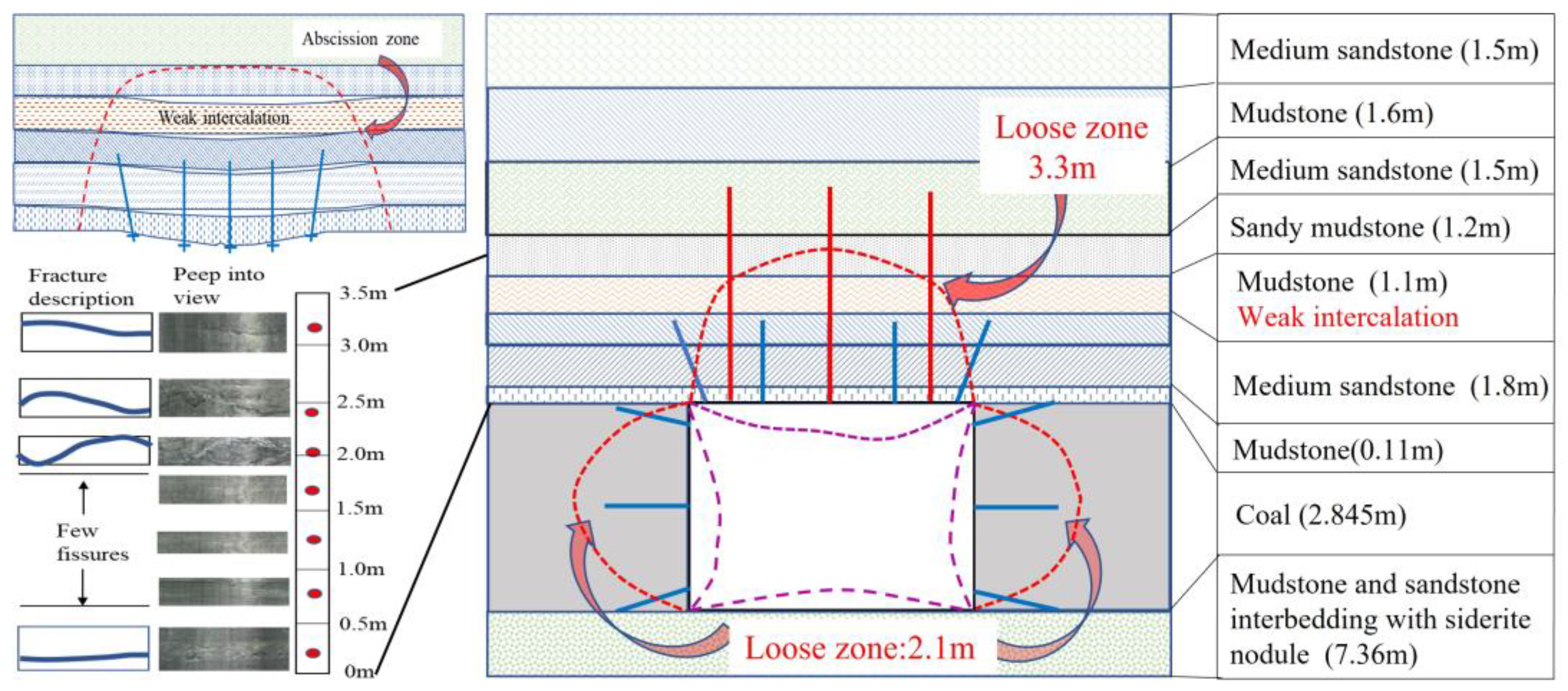

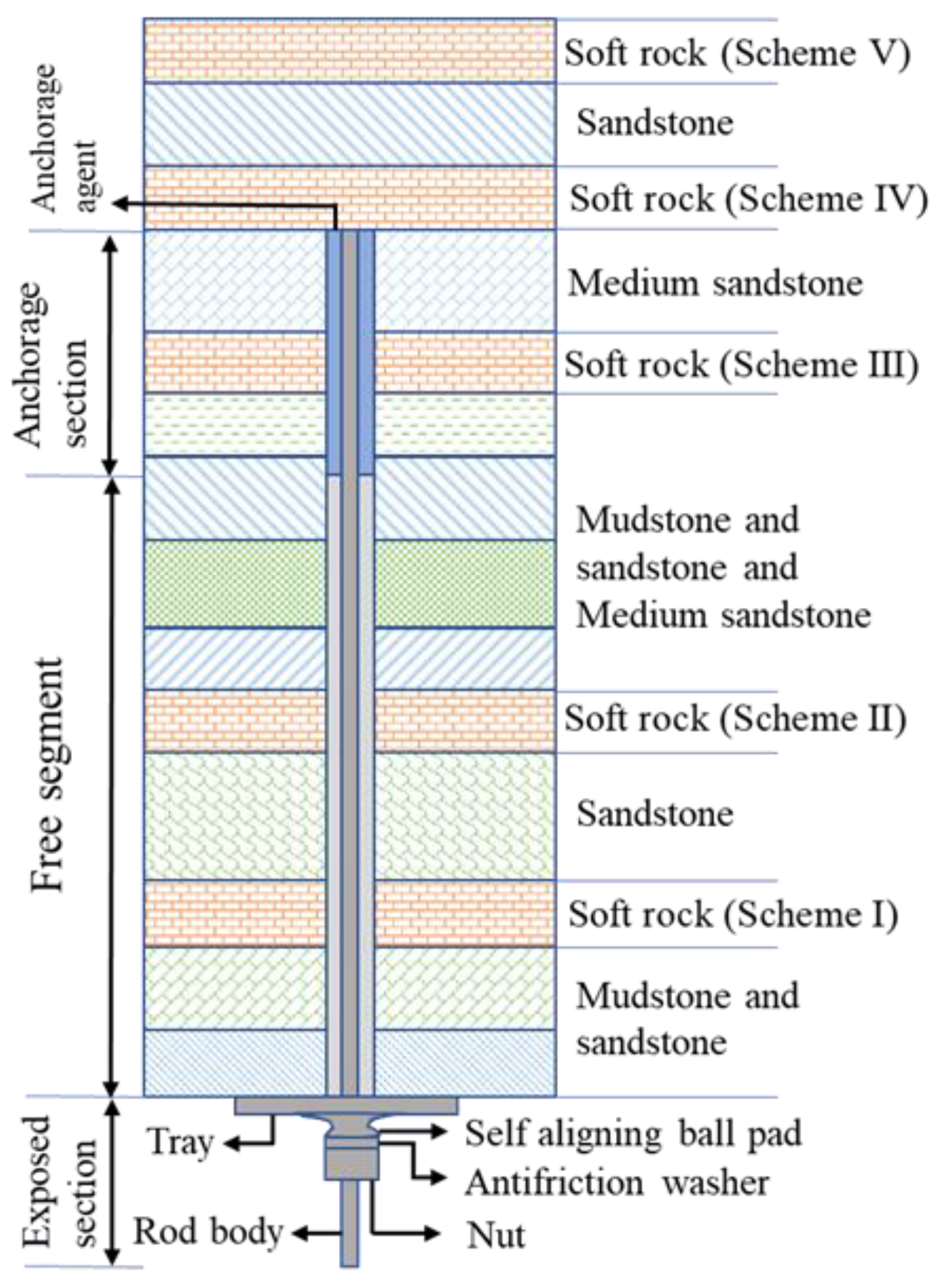
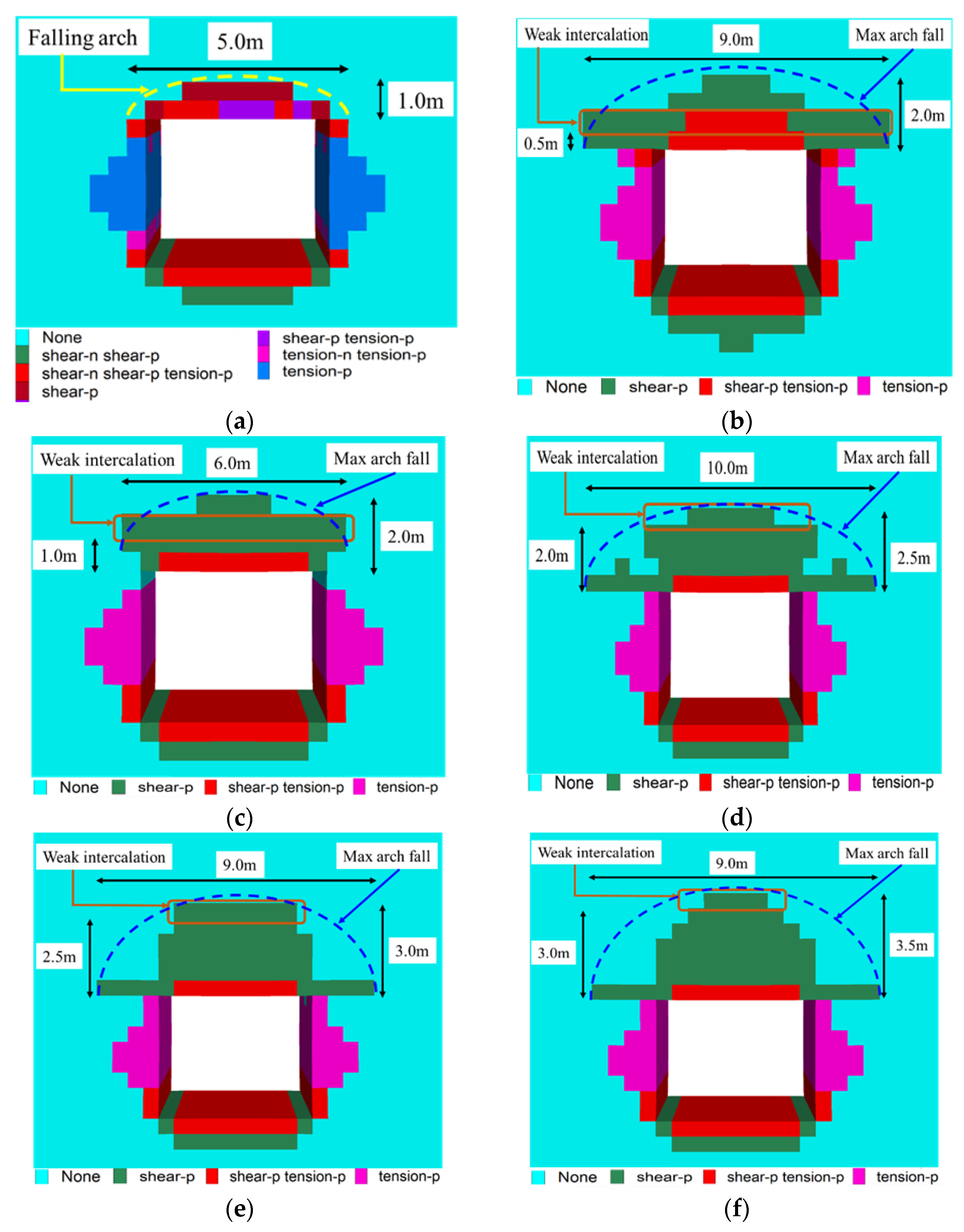
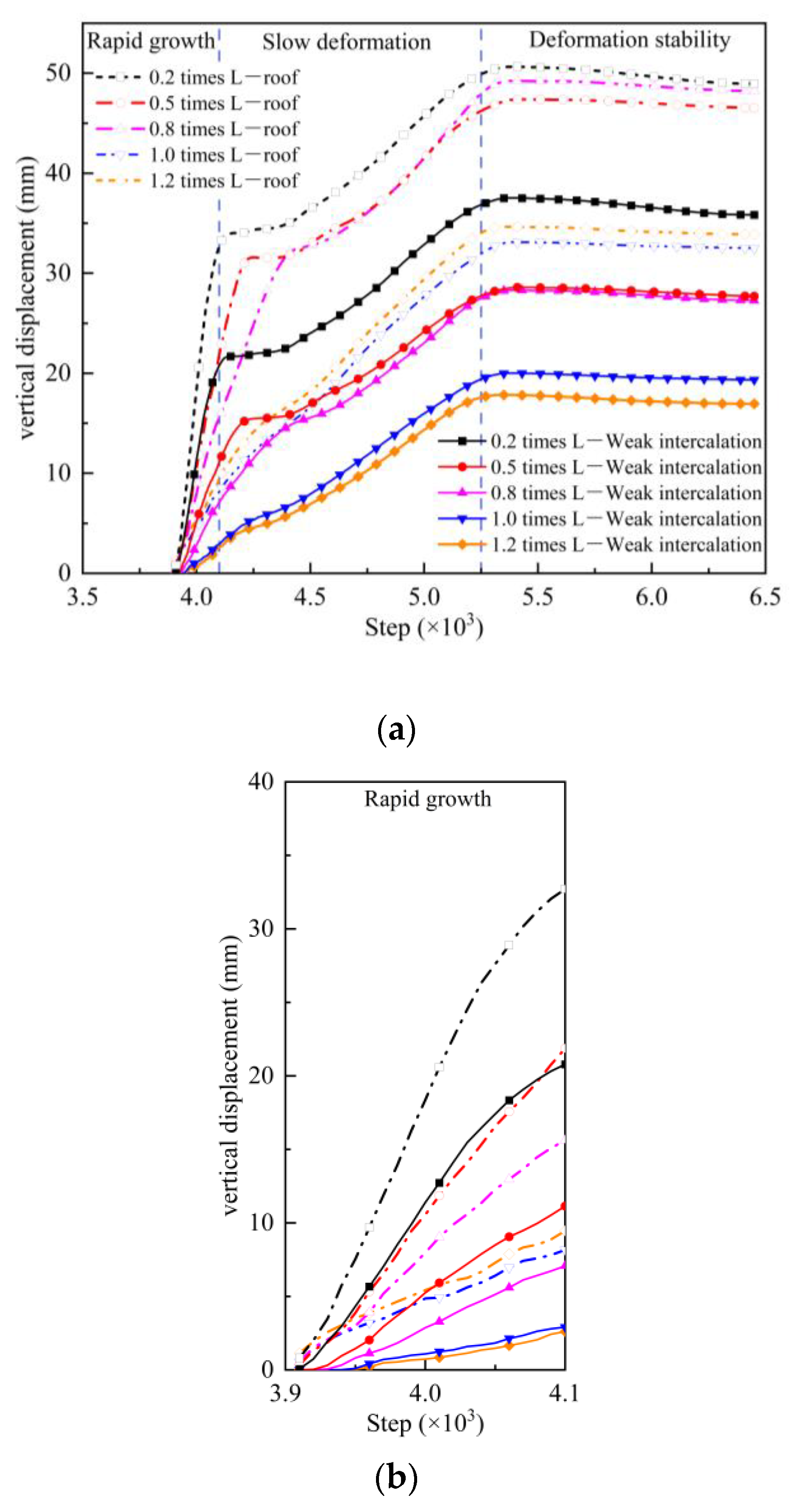
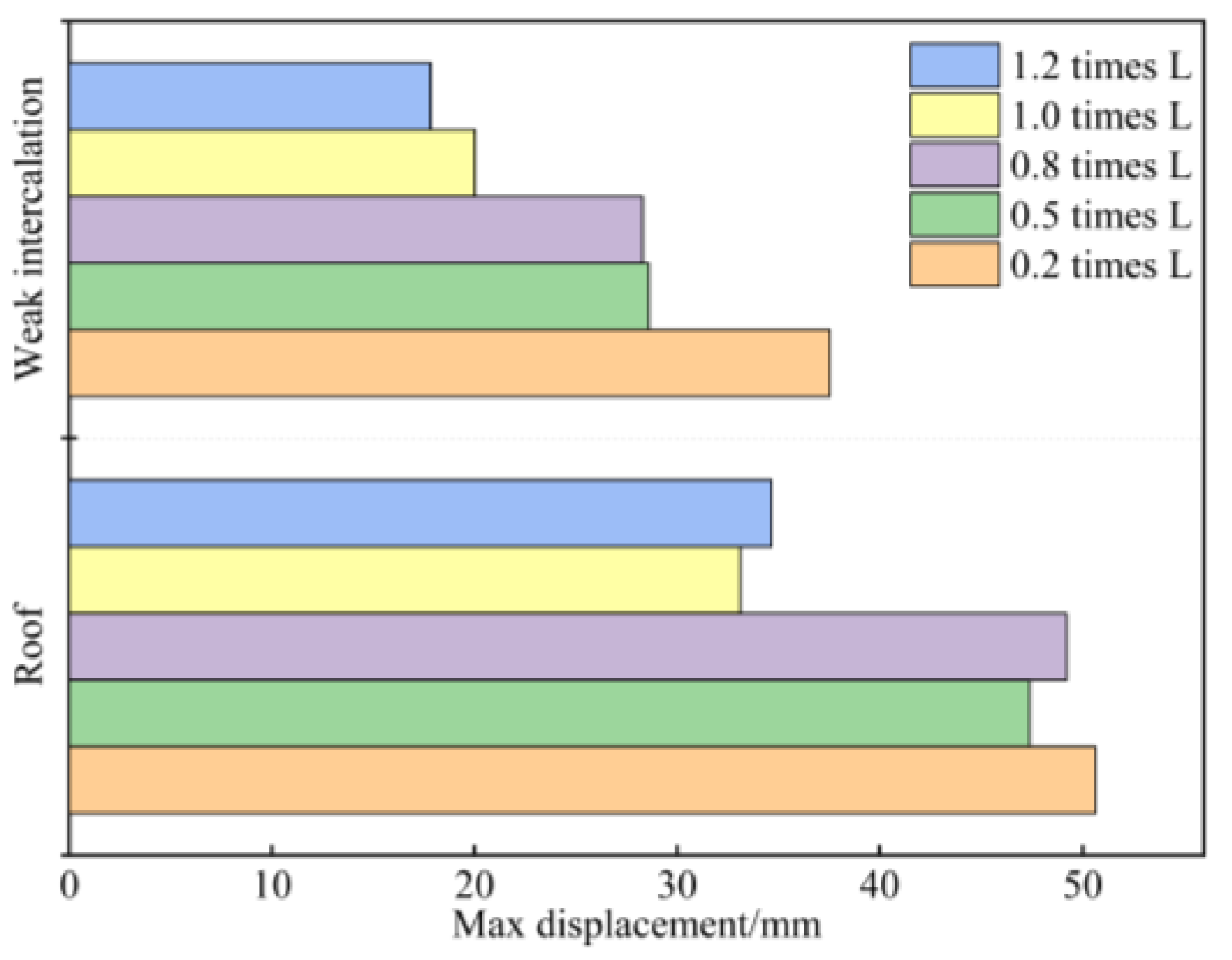




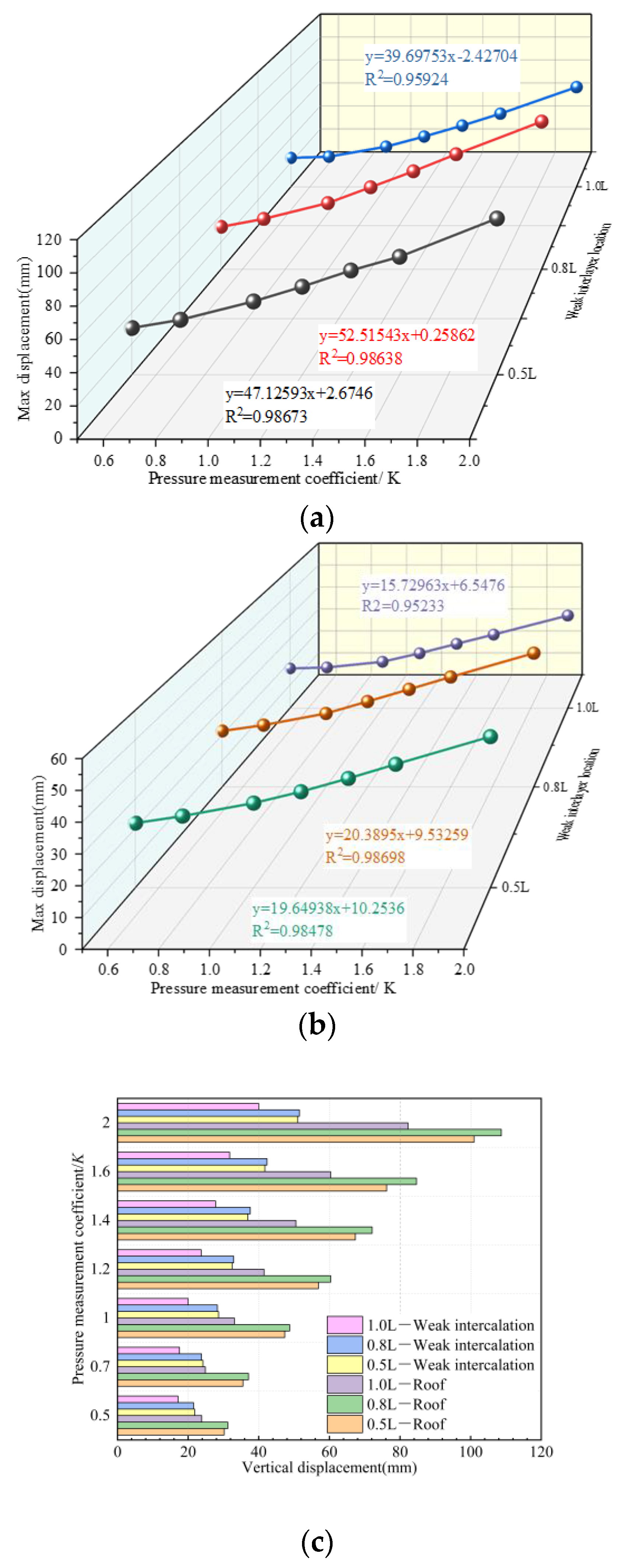
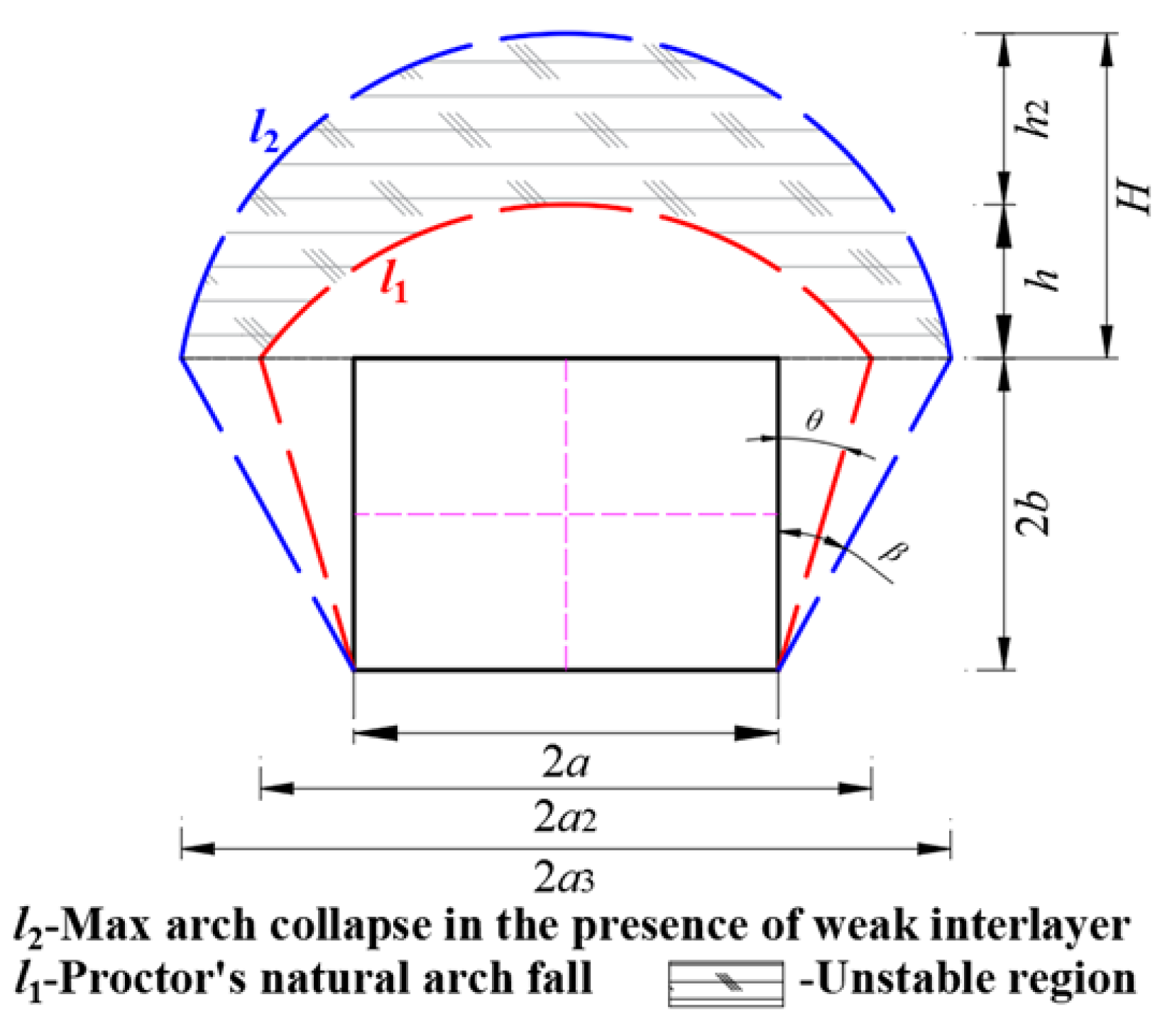




| Lithology Classification | P (kg/m3) | V0 (Gpa) | G (Gpa) | Coh (Mpa) | Fric (°) | Rm (MPa) | Remarks |
|---|---|---|---|---|---|---|---|
| Medium sandstone | 2500 | 10.6 | 3.2 | 3.3 | 42 | 1.4 | |
| Sandy mudstone | 2600 | 14.5 | 6.3 | 5.6 | 38 | 1.842 | |
| Mudstone | 2400 | 8.26 | 2.7 | 6.7 | 42 | 1.4 | |
| Coal | 1750 | 4.23 | 1.25 | 6.7 | 32 | 2 | |
| Mudstone | 2200 | 0.5 | 0.7 | 2.3 | 23 | 0.65 | Weak interlayers |
| Mudstone sandstone interbed | 2500 | 9.8 | 5.2 | 4.3 | 38 | 1.62 | floor |
| Scheme | Scheme I | Scheme II | Scheme III | Scheme IV | Scheme V | Control Group |
|---|---|---|---|---|---|---|
| Relative anchor position | Range of the free section | Anchorage section | Anchorage section edge | Outside the anchoring range | / | |
| 0.2 times L | 0.5 times L | 0.8 times L | 1.0 times L | 1.2 times L | 0.0 L | |
| From top plate | 0.5 m | 1.0 m | 2.0 m | 2.5 m | 3.0 m | / |
| Lateral pressure coefficient (K) | 0.5 | 0.7 | 1.0 | 1.2 | 1.4 | 1.6 | 2.0 |
| Horizontal stress/MPa | 10 | 14 | 20 | 24 | 28 | 32 | 40 |
| Location of the Weak Rock Stratum | Scheme I | Scheme II | Scheme III | Scheme IV | Scheme V | Scheme VI | Scheme VII |
|---|---|---|---|---|---|---|---|
| 0.5 times L | K = 0.5 | K = 0.7 | K = 1.0 | K = 1.2 | K = 1.4 | K = 1.6 | K = 2.0 |
| 0.8 times L | |||||||
| 1.0 times L |
| Pressure Measurement Coefficient/K | Location of Weak Intercalation | Maximum Arch Fall | Maximum Collapse Angle of the Upper/β(°) | |
|---|---|---|---|---|
| Span/2a3(m) | Height/H(m) | |||
| K < 1 | Anchor rod free section | 1.2 times L | hi | arctan[(0.6 L-a)/2b] |
| Anchor section | hi or L | |||
| Above anchor rod | 1.3 times L | |||
| 1 < K < 2 | Anchor free section and anchor section | 2(1.2~2.4)a | (1.3~1.5) times L | arctan[(0.1~1.4)a/2b] |
| Above anchor rod | 4a | 1.3 times L | arctan(a/2b) | |
| K ≥ 2 | Anchor free section, anchor section and above anchor | 8a | 1.7 times L | arctan(3a/2b) |
| Borehole No | 1 | 2 | 3 | 4 | 5 | |
|---|---|---|---|---|---|---|
| Location of soft rock/mm | Lower boundary | 2215–2243 | 2225–2252 | 2231–2234 | 2221–2213 | 2223–2298 |
| Upper boundary | 3226–3312 | 3223–3246 | 3234–3353 | 3296–3323 | 3302–3319 | |
| Borehole No | 6 | 7 | 8 | 9 | 10 | |
| Location of soft rock/mm | Lower boundary | 2122–2203 | 2186–2206 | 2188–2212 | 2195–2206 | 2210–2221 |
| Upper boundary | 3233–3243 | 3219–3223 | 3226–3324 | 3206–3326 | 3265–3384 | |
| Layer Separator No. | 1 | 2 | 3 | 4 | 5 | 6 | 7 | 8 | 9 | 10 |
|---|---|---|---|---|---|---|---|---|---|---|
| 2.0 m | 12 | 11 | 17 | 23 | 20 | 19 | 15 | 8 | 12 | 20 |
| 6.0 m | 8 | 5 | 9 | 10 | 12 | 10 | 9 | 7 | 6 | 5 |
Disclaimer/Publisher’s Note: The statements, opinions and data contained in all publications are solely those of the individual author(s) and contributor(s) and not of MDPI and/or the editor(s). MDPI and/or the editor(s) disclaim responsibility for any injury to people or property resulting from any ideas, methods, instructions or products referred to in the content. |
© 2023 by the authors. Licensee MDPI, Basel, Switzerland. This article is an open access article distributed under the terms and conditions of the Creative Commons Attribution (CC BY) license (https://creativecommons.org/licenses/by/4.0/).
Share and Cite
Wang, J.; Zheng, X.; Liu, C.; Li, P.; Guo, X.; Xu, W. The Roof-Fall Mechanism and Support-While-Drilling Technology of the Rectangular Roadway with Layered Roofs and Weak Interlayers. Processes 2023, 11, 1198. https://doi.org/10.3390/pr11041198
Wang J, Zheng X, Liu C, Li P, Guo X, Xu W. The Roof-Fall Mechanism and Support-While-Drilling Technology of the Rectangular Roadway with Layered Roofs and Weak Interlayers. Processes. 2023; 11(4):1198. https://doi.org/10.3390/pr11041198
Chicago/Turabian StyleWang, Jiyu, Xigui Zheng, Cancan Liu, Peng Li, Xiaowei Guo, and Wenjie Xu. 2023. "The Roof-Fall Mechanism and Support-While-Drilling Technology of the Rectangular Roadway with Layered Roofs and Weak Interlayers" Processes 11, no. 4: 1198. https://doi.org/10.3390/pr11041198
APA StyleWang, J., Zheng, X., Liu, C., Li, P., Guo, X., & Xu, W. (2023). The Roof-Fall Mechanism and Support-While-Drilling Technology of the Rectangular Roadway with Layered Roofs and Weak Interlayers. Processes, 11(4), 1198. https://doi.org/10.3390/pr11041198







